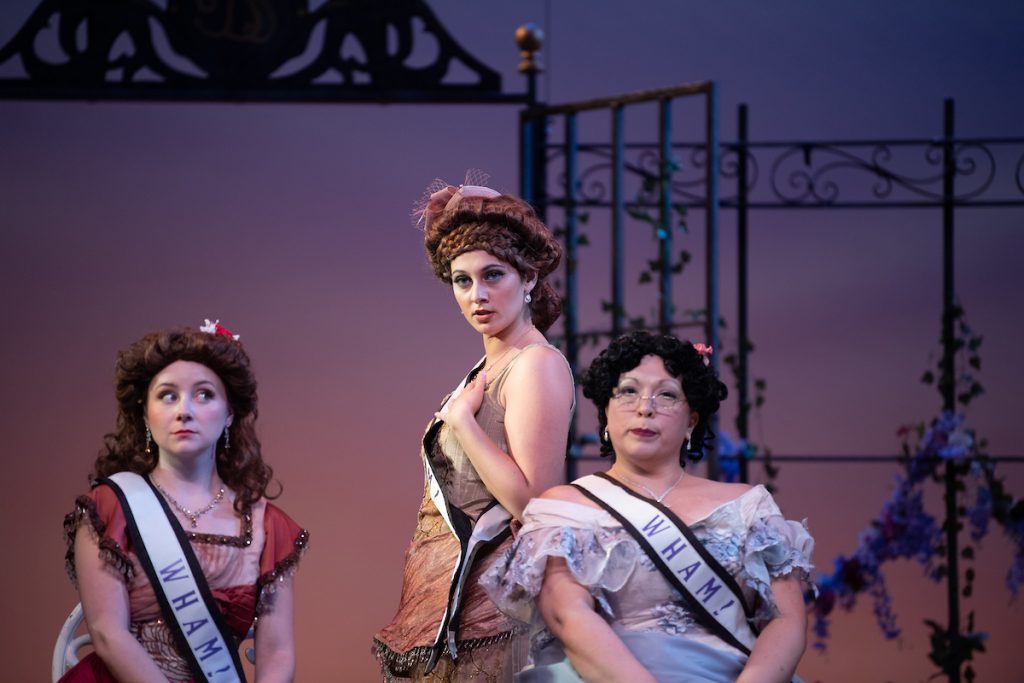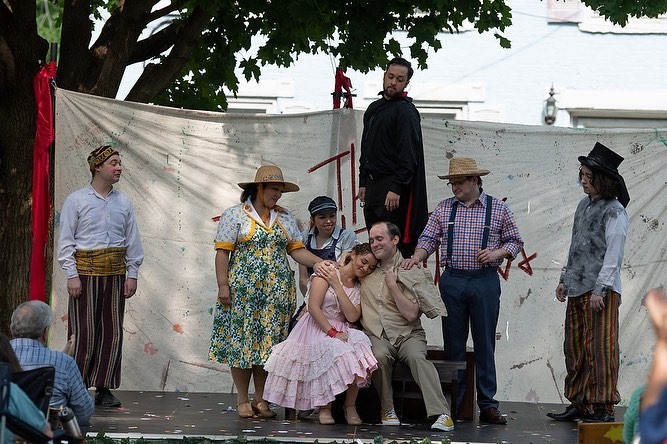by Daniel Hathaway

This summer’s titles include Cinderella, Hello, Dolly!, The Student Prince, The Pirates of Penzance, The Mock Marriage, and The Fantasticks. All six titles are currently running in repertoire until July 31, and all six are well worth the trip to Wooster. Click here for ticket availability.
This is light opera and musical theatre at its best. The young professional ensemble exudes theatrical and vocal talent and the leads wouldn’t be out of place in any provincial opera company. The Orchestra, skillfully led by Michael Borowitz and Wilson Southerland is first class and in addition to the acting, singing, and dancing, the productions are visually gorgeous.
OLO stands out in Northeast Ohio as the only company that fully embraces the resident ensemble model. It’s fun to see singers playing a lead role in one show and a secondary character in another, and doing everything splendidly.
ClevelandClassical.com has attended all six shows in OLO’s slightly attenuated 2022 season — the first to be presented in-person since COVID arrived in 2020. Here are some of our comments:

Throughout the opening performance on June 30, the young professional cast stayed in complete musical control…“Overhead the Moon Is Beaming,” stands out as one of the score’s best [songs]. Its large, intervallic leaps really take a trained voice to pull off, and Benjamin Krumreig as the title character, Prince Karl Franz, gave his delivery…a burnished tenor sound.
Lauren Nash Silberstein as the local waitress and love interest, Kathie, flashed considerable coloratura skill in the work’s other memorable number, “Come Boys, Let’s All Be Gay, Boys.”…It was the comedic actors who commanded the stage. Vincent Gover as Lutz and Michelle Pedersen as the Grand Duchess Anastasia committed to ridiculous roles and slapstick bits that less confident performers would shy away from. Which puts The Student Prince in a funny position. No great story emerges from this piece, but audiences can expect a high level of music-making and an amusing time — which is the tradition of light theater after all. And OLO carries the mantle year after year.

What immediately strikes the listener is the sophistication of Lehár’s writing, and particularly his colorful orchestration, brought to life by the excellent OLO Orchestra at Freedlander Theatre. Cast and orchestra were skillfully led by Michael Borowitz…. The score is rich with different musical forms — polkas, waltzes — and with references both in the book and the score to the music of Wagner, Victor Herbert, and — not so charitably — rival operetta composer Sigmund Romberg.
Strong performances by WHAM members Miss Phoebe (Joelle LaChance), Miss Edith (Sadie Spivey), and Miss Euphrasia (Michelle Pedersen) — women you don’t want to cross arguments with — added humor and spice to the story. Jonathan Heller made a splash as the speed demon motorist Philly Kaps (“ninety-one miles an hour”).

Although its musical forces have changed over time (the show was originally scored for harp and piano), the simplicity and directness of its songs remains its main source of charm. Such tunes as “Try to Remember (the Kind of September)” and “Soon it’s Gonna Rain” are sentimental and affecting and stick in the memory. Humorous but wise songs like “Never Say No” and “Plant a Radish (Get a Radish)” dispense eternal truths in the form of kernels of wisdom.
Sadie Spivey, who was such an impressive Mable in Pirates of Penzance, stood out again here as Luisa both for her vocal prowess and masterful acting ability. Spencer Reese played a sweet-voiced and affecting Matt (he also choreographed the show). Vincent Gover and Edward Ferran were hilarious as the over-the-hill Shakespearean actor Henry and his sidekick Mortimer, whose specialty is dying onstage. Mark Hosseini, last seen as the Pirate King in Pirates of Penzance, was a dashing El Gallo, that unconvincing villain. And if you need to cast the role of a wall — say in your next production of A Midsummer Night’s Dream — look no further than the eloquent Mute, Lily Graham.

Subtitled “The Slave of Duty,” the show spins its plot around young Frederick, sung by the clear-voiced tenor Spencer Reese, who does double duty as choreographer of the show’s athletic ensemble numbers.
This season’s Ohio Light Opera company boasts excellent acting and ensemble skills, and is unusually long on vocal talent. Mable’s coloratura aria, “Poor Wandering One,” could serve as an audition piece for the role of Queen of the Night, and Sadie Spivey made it a show-stopper, with beautiful tone and phrasing, flawless diction, and vibrant high notes.
The famous patter song, “I Am the Very Model of a Modern Major-General,” itself the model for such tongue-twisting knockoffs as Tom Lehrer’s The Elements Song, gave Vincent Gover the opportunity to demonstrate expert breath control, pacing, and elocution, earning gold stars in each column, while occasionally stepping out of character for a line or two. “I can hum a fugue of which I’ve heard the music’s din afore, and whistle all the airs from that infernal nonsense Pinafore,” he sang with a knowing wink.
In the pit, conductor Wilson Southerland paced the score adroitly and drew fine playing from the OLO Orchestra. The audience was part of the event from the beginning, rising from their seats to join in singing God Save the Queen, once a mildly seditious act for Americans, but now part of Savoyard lore.
Visually gorgeous, the colorful production was designed by Kiah Kayser, lit by Daniel Huston and Rachel Aho, and costumed by Cindy Moon. Humorous touches abounded in Steven Daigle’s direction, like the Major-General’s oversized bunny slippers, the awkwardness of the police constables, and their treacle-thick cockney accents.

Originally produced for television in 1957 — seven years after the animated Disney film was released — and starring Julie Andrews, according to the Rodgers & Hammerstein website, the show was viewed by over 100 million people.
Cinderella begins in the village, a bright scene where our heroine feels free amongst people running their errands. It is with this sense of participation in a community where Cinderella, played with appropriate naïveté by Alexa Lowrey, feels most like everyone else.
The insufferable stepmother, played by Michelle Pedersen in her third season at OLO, fails to teach her daughters — Cinderella’s outrageous stepsisters (Sarah Best and Abby Kurth) — about how to behave. They scratch themselves and hike up their dresses, they sit with a slouch while their knees lean away from each other, they laugh and snort and fail to compose themselves in respectable company.
Jonathan Heller’s Prince Christopher walks the boards with stubbornness and incredulity, determined to rebel against the ball being thrown by his parents, the King and Queen, and marry for love.

At this point, something quite magical happened in Wooster. Michelle Pedersen had taken a while to live into her character, but Dolly emerged in full force during the parade scene, and swept the rest of the cast along with her into the restaurant, where the corps of servers treated the matchmaker to a heroine’s welcome in a big production number featuring the title song. This is a show with a single big tune, and the full cast sang it lustily.
Songs like “The Waiters’ Gallop” were cleverly choreographed (by Spencer Reese) and crisply executed. The sight gags worked, dialogue was clear and understandable, and coordination between the stage and orchestra, led by Wilson Southerland, was excellent. The lighting (Brittany Shemuga) and set design (Kiah Kayser) complemented the beautiful period costuming (Cindy Moon).
All in all, an excellent show with scarcely any opening performance jitters…director Jacob Allen for joining all its elements into a delightful production.
Photos by Matt Dilyard.
Published on ClevelandClassical.com July 22, 2022.
Click here for a printable copy of this article



